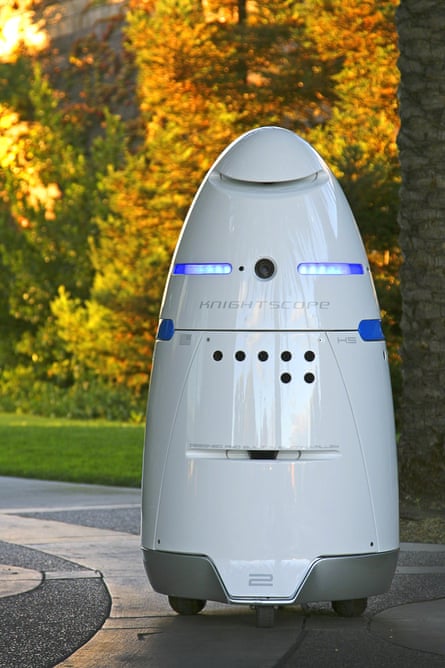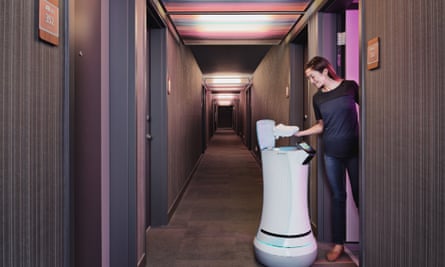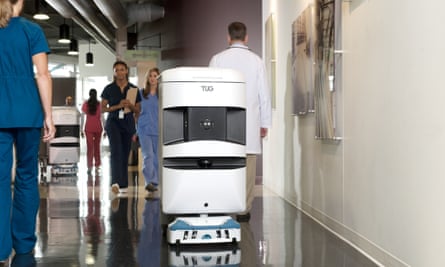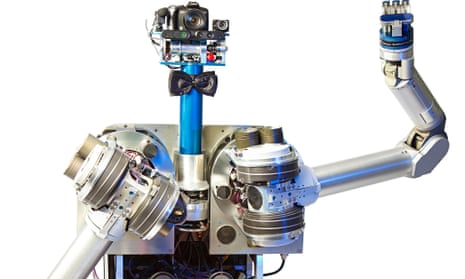It could be said that the job of bridge toll collector was invented in San Francisco. In 1968, the Golden Gate Bridge became the world’s first major bridge to start employing people to take tolls.
But in 2013 the bridge where it all began went electronic. Of its small band of collectors, 17 people were redeployed or retired and nine found themselves out of work. It was the software that did it – a clear-cut case of what economists call technological unemployment. Licence-plate recognition technology took over. Automating jobs like that might not seem like a big deal. It is easy to see how it might happen, just as how we buy train tickets at machines or book movie tickets online reduces the need for people.
But technology can now do many more things that used to be unique to people. Rethink Robotics’ Baxter, a dexterous factory robot that can be programmed by grabbing its arms and guiding it through the motions, sells for a mere $25,000 (equivalent to about $4 an hour over a lifetime of work, according to a Stanford University study). IPsoft’s Amelia, a virtual service desk employee, is being trialled by oil industry companies, such as Shell and Baker Hughes, to help with employee training and inquiries. Meanwhile, doctors are piloting the use of Watson, IBM’s supercomputer, to assist in diagnosing patients and suggesting treatments. Law firms are using software such as that developed by Blackstone Discovery to automate legal discovery, the process of gathering evidence for a lawsuit, previously an important task of paralegals. Rio Tinto’s “mine of the future” in Western Australia has 53 autonomous trucks moving ore and big visions for expansion. Even the taxi-sharing company Uber is in on the act – it has just announced it will open a robotics research facility to work on building self-driving cars.

The upshot will be many people losing jobs to software and machines, says Silicon Valley-based futurist Martin Ford, whose book The Rise of the Robots comes out this year. He forecasts significant unemployment and rising inequality unless radical changes are made. Until recently, says Ford, such predictions risked you being branded a Luddite.
Based on past history, standard economic wisdom holds that technology creates as many jobs as it destroys and makes people better off by making goods and services cheaper. But, Ford adds, it is increasingly obvious that we are becoming less and less useful compared to machines. Every day, he says, brings new examples of technology set to spell the end of someone’s job. Nearly half of almost 2,000 experts recently surveyed by the Pew Centre said technology will have displaced more jobs than it creates by 2025.
Under threat, stresses Ford, are not just the jobs of people who work with their hands but those who work with their minds, including professionals. “Robots aren’t just in factories threatening blue-collar workers,” Ford says. “It is really now anyone who sits in front of a desk doing any kind of job that involves manipulating information – especially if it is more routine and formulaic.”
As an example, he cites New York- based startup Work Fusion, which sells software to businesses to automate big projects that would previously have been done by office workers, such as updating company records or extracting specific information from internet websites. The software divides the job into micro-tasks, automates the repetitive bit then recruits freelance workers through crowdfunding platforms for tasks that require thinking. The remarkable thing about the system, notes Ford, is that as it manages these freelance workers it monitors what they are doing and learns from them so, over time, it can automate more and more: “As the freelance workers do their jobs they are, in effect, training the system to replace them. That’s a pretty good preview of what the future looks like.”
Of course most companies say the goal is not to replace workers but free them for other tasks. But Ford argues that technology combined with capitalism naturally tends towards making the economy less labour-intensive. Don’t be surprised if it is hard to find examples of people directly losing their jobs to automation like those on the Golden Gate Bridge, he adds. Most commonly, jobs are eliminated during an economic downturn and then, when the recovery comes, employers find technology allows them to avoid rehiring people.
Ford’s book isn’t the first in recent times to sound alarm bells. It follows last year’s influential The Second Machine Age by Erik Brynjolfsson and Andrew McAfee, business school academics at the Massachusetts Insitutute of Technology (MIT) Sloan School of Management. They also warned we face significant overall job loss from computers, robots and automation unless we institute radical change. There is no economic law that says technological progress has to result in job creation and shared prosperity, they say. Rather, we are about halfway into a century-long transformation that moves us from merely automating physical work to automating mental work, a process that started with the first computer boom in the 1970s. The effects are just becoming noticeable now because exponential growth by its nature takes time to build up. “Machines are better than humans in many tasks right now, from playing chess to legal discovery to medical diagnosis,” says Brynjolfsson. “That will just accelerate.”

Artificial intelligence and machine-learning technology that allow computers to make decisions, recognise speech and visualise in 3D are the main driver of the process, says Ford. They are leading to the development of both algorithms and new robots that can perform all sorts of previously non-automatable tasks.
“Little bits of artificial intelligence are all over the place now,” says Murray Shanahan, a cognitive robotics expert at Imperial College London. For example: automated call systems that recognise voice commands. But what is coming is more sophisticated. When it comes to robots, he adds, most of the automation of manual tasks we have seen has occurred in highly engineered settings where the task can easily be specified for the robot without it having to understand the environment. We have had automation of car assembly lines for decades, but the whole plant has needed to be carefully designed – tools and components in particular predetermined places – so the robots can repeat mind-bogglingly precise tasks. But with AI boundaries can be pushed. Google’s self-driving car, which is essentially just a robot, is being taught to operate in the real, unpredictable world.
The question is what do humans do next? When you automate the physical work you still need humans to be the control system, says Brynjolfsson. But when you automate the control system, “then it is less clear what the role for humans is”. Ford comments: “There isn’t another big sector of the economy to absorb all these workers.”
The US has experienced measurable net technological unemployment for about the past decade and a half, Brynjolfsson and McAfee argue. Productivity (the output for the labour input), private sector employment and median income have all risen roughly together. But in about 2000 a divergence began, which continues. Productivity has continued to increase while employment and median income have stagnated and even fallen. “I call it the great decoupling,” says Brynjolfsson. “It is a different pattern than what we have seen during the preceding 200 years, [and] the biggest single explanation is that technology has been affecting far more middle-skilled jobs.” Concentrated in the middle it hollows out this group, making things more unequal.
To analyse the skills most affected, Brynjolfsson and McAfee categorise jobs as routine or non-routine and then again by whether they are cognitive or manual. The routine jobs – both cognitive (say payroll clerk) and manual (say assembly line worker) – are falling away most dramatically while the non-routine – both cognitive (say financial analyst) and manual (chambermaid) – have held up better so far because they turn out not to be simple and repetitive in a way that can be easily programmed.
But they note that the boundaries of what counts as routine and non-routine are moving all the time. It was once thought that driving was a skill so complex it couldn’t be automated only to see it turned on its head by Google and others. Dexterous robots such as Baxter can now do some non-routine manual tasks as well and skills such as medical diagnosis and legal analysis, once thought of as non-routine cognitive, are increasingly becoming automatable.

Michael Osborne and Carl Frey from Oxford University have put numbers to Brynjolfsson and McAfee’s job loss predictions. In a report published last year, they conclude that 35% of UK jobs were at high risk of disappearing in 10 to 20 years because of automation. (An earlier study of the US, which has more manufacturing, suggested 47% of jobs were at high risk). They used a different method for estimating the vulnerability of occupations focused on the extent to which people’s jobs involved three types of task – originality, social intelligence and interacting with complex objects in unstructured environments, which comes naturally to us but is hard for robots. The more a job involved those tasks, the less likely it was to become automated, they estimated.
Job categories most at risk tended to be low-skilled and were in office and administrative support; sales and services; transport; construction and extraction; and manufacturing. Among the highest risk jobs were telemarketers, payroll managers and wages clerks, bank and post office clerks, local government administrative occupations, assembly line workers, taxation experts, accountants, retail assistants and waiters.
We may even already have seen social unrest as a result of people losing jobs to technology, believe Brynjolfsson and McAfee, citing movements such as Occupy and the Tea Party. “People feel they are not getting a fair deal,” says McAfee. “They blame different parties … [but] there is this tectonic force in the background that I would call technological progress.” Osborne and Frey’s job categories least at risk tended to be high ability and spanned skilled management; financial services; computing, engineering and science; education; legal services; community services; arts and media; and healthcare. Among the lowest-risk jobs were: hotel managers, doctors, teachers, nurses, architects, lawyers, management consultants, IT systems designers, childcare workers, artists and journalists.
Not every component of the highest risk jobs may be automatable, says Osborne. For example, we may well make orders on tablet computers at restaurant tables, but staff will still bring the plates. Likewise, some components of low-risk jobs may incorporate elements of automation – algorithms can now write simple finance and sports news stories once done by journalists, for example – but it doesn’t mean those jobs will disappear anytime soon because of the skills they require.
“I think a lot of the risk to professions has been overhyped,” says Osborne. “Yes some component of doctoring is going to be automatable, but a lot of what doctors do is interacting with people … these algorithms will free them up to do more of that.” Medicine will be an interesting test bed, says McAfee: “There is a lot of potential for automation but also for resistance from patients, who don’t want to be diagnosed by a machine.”
Yet the picture painted by the doomsayers does not resonate with many economists. Jobs will always be “destroyed” by technological change, says David Autor, an economist at MIT, citing how there are not many train firemen (they shovelled the coal into steam locomotives), typists and lift operators left in advanced economies. But this has not reduced employment in aggregate or lowered earnings levels on average. It has done the opposite: raised productivity on average and led to more interesting, more cognitively challenging, better paid and less dangerous jobs.
To focus on jobs destroyed is like writing a history of the economic impacts of the motor car that focuses entirely on the plight of blacksmiths and stable boys, he says. “It sows panic without adding to understanding.” Job displacement is highly disruptive and even traumatic for those who experience it, he notes, but in time new sectors open up. (A figure of 35% of jobs at risk does not mean employment will be 35% lower.)
Alan Manning, an economist at the London School of Economics, takes issue with the assertion that economic trends observed in the US are caused by technological unemployment. While he agrees US data shows rising productivity and stagnating employment, it isn’t the case in Britain. For about a decade UK productivity has been stagnating while employment, if anything, is up. If technology was having a big effect, he argues, it might show up in US data a bit earlier but wouldn’t be entirely absent elsewhere.
“They are citing a pattern that isn’t true of many other of the most advanced economies,” he says. “Which makes me think other stuff is going on here.” The UK’s situation suggests that there has not been too much investment in machines, but too little.

All the talk of robots taking jobs makes Gavin Kelly at the Resolution Foundation, a UK-based thinktank focused on improving the living standards of low- to middle-income earners, fret for different reasons. He is optimistic that technology will not end work and is also confident that we are capable of adapting to the big shifts in employment he expects over the next 30 years as technology churns things up. What he worries about is that all the rhetoric about robots might spook politicians into not pushing for better wages.
Others note the technology still has a long way to go. Might Google’s showy self-driving car lead people to extrapolate a little too far? There are many tasks we do effortlessly that we don’t explicitly understand, yet those “rules” are exactly what is necessary for them to be computerised, notes Autor. There will still be plenty of room for humans, with common sense and judgment, to complement the work of machines, he believes.
Rodney Brooks, founder of Rethink Robotics which makes Baxter, dreams of the day when we will truly have robots with arms that can manipulate stuff. We need them to do all the unskilled jobs no one wants, including providing care for our ageing population, he says. But the technological challenge of making robots dexterous is “massive” (something that doesn’t afflict the self-driving car). “We have a lot of stuff we have no clue how to do,” he says. He cites a problem he calls the “bin of parts”. While a person can reach in to a bin full of jumbled parts and grab the right one, a robot still can’t.
In 2010 researchers at the University of California, Berkeley, programmed a robot to fold a pile of towels (videos of it went viral). But it took the robot, which cost $400,000 to buy, 25 minutes a towel, with most time spent working out how to grasp it. The researchers have been working on trying to get it to do a full cycle of laundry, but many areas seem to hamper it.
If you still don’t feel reassured, Brynjolfsson, McAfee and Ford offer suggestions about how to avoid being usurped by a robot or lines of code. Just as a bad outcome isn’t impossible, neither is it inevitable.
Individuals should cultivate skills, such as idea generation, where humans currently have the comparative advantage, and select job types that are not so subject to the head-to-head race against machines.
Recommendations for policymakers include boosting entrepreneurs to enable them to invent the new industries and jobs necessary to replace the old ones and refocusing education to emphasise creativity and interpersonal skills.
They all float the idea of basic guaranteed incomes for everyone, or tax credits to supplement low-wage workers.
“We are going to have to restructure our economy and society to deal with this,” says Ford. If we did, he adds, we could live in a world where we all have a lot more leisure time. If all else fails, in the words of one prominent Silicon Valley venture capitalist, Steve Jurvetson: “We’ll probably make good pets.”








Comments (…)
Sign in or create your Guardian account to join the discussion